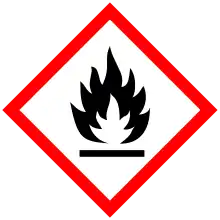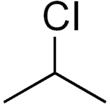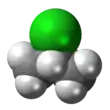Isopropyl chloride
Isopropyl chloride is an organic compound with the chemical formula (CH3)2CHCl. A colorless, flammable liquid, it is used industrially as a solvent. It is produced by the addition of HCl to propylene:[1]
- CH3CH=CH2 + HCl → (CH3)2CHCl
| |||
| Names | |||
|---|---|---|---|
| IUPAC name
2-chloropropane | |||
| Other names
chlorodimethylmethane, isopropyl chloride, 2-propyl chloride, sec-propyl chloride, 2-chloropropane | |||
| Identifiers | |||
3D model (JSmol) |
|||
| ChemSpider | |||
| ECHA InfoCard | 100.000.781 | ||
| EC Number |
| ||
PubChem CID |
|||
| RTECS number |
| ||
| UNII | |||
| UN number | 2356 | ||
CompTox Dashboard (EPA) |
|||
| |||
| |||
| Properties | |||
| C3H7Cl | |||
| Molar mass | 78.5413 | ||
| Appearance | Colourless liquid | ||
| Density | 0.862 | ||
| Melting point | −117.18 °C (−178.92 °F; 155.97 K) | ||
| Boiling point | 35.74 °C (96.33 °F; 308.89 K) | ||
| 0.334 g/100 ml at 12.5 °C | |||
| Solubility in ethanol | miscible | ||
| Solubility in diethyl ether | miscible | ||
Refractive index (nD) |
1.3811 | ||
| Viscosity | 4.05 cP at 0 °C 3.589 cP at 20 °C | ||
| Hazards | |||
| Main hazards | Possible mutagen. May be harmful by ingestion, inhalation or through skin contact. | ||
| Safety data sheet | External MSDS | ||
| GHS pictograms |   | ||
| GHS Signal word | Danger | ||
| H225, H302, H312, H332 | |||
| P210, P233, P240, P241, P242, P243, P261, P264, P270, P271, P280, P301+312, P302+352, P303+361+353, P304+312, P304+340, P312, P322, P330, P363, P370+378, P403+235, P501 | |||
| NFPA 704 (fire diamond) | |||
| Flash point | −32 °C (−26 °F; 241 K) | ||
| Related compounds | |||
Related alkyl halides |
Ethyl chloride n-propyl chloride Isopropyl bromide Isopropyl iodide | ||
Except where otherwise noted, data are given for materials in their standard state (at 25 °C [77 °F], 100 kPa). | |||
| Infobox references | |||
It reacts with magnesium to give isopropylmagnesium chloride.[2]
Further reading
- Ann Smith, Patricia E. Heckelman (2001). "The Merck Index". In Maryadele J. O'Nei (ed.). An Encyclopedia of Chemicals, Drugs, and Biologicals (Thirteenth ed.). Whitehouse Station, NJ: Merck & Co., Inc. p. 932.
References
- M. Rossberg; et al. (2006). "Chlorinated Hydrocarbons". Ullmann's Encyclopedia of Industrial Chemistry. Weinheim: Wiley-VCH. doi:10.1002/14356007.a06_233.pub2.
- Johnnie L. Leazer, Jr; Raymond Cvetovich (2005). "A Practical and Safe Preparation of 3,5-Bis(trifluoromethyl)acetophenone". Org. Synth. 82: 115. doi:10.15227/orgsyn.082.0115.
This article is issued from Wikipedia. The text is licensed under Creative Commons - Attribution - Sharealike. Additional terms may apply for the media files.


